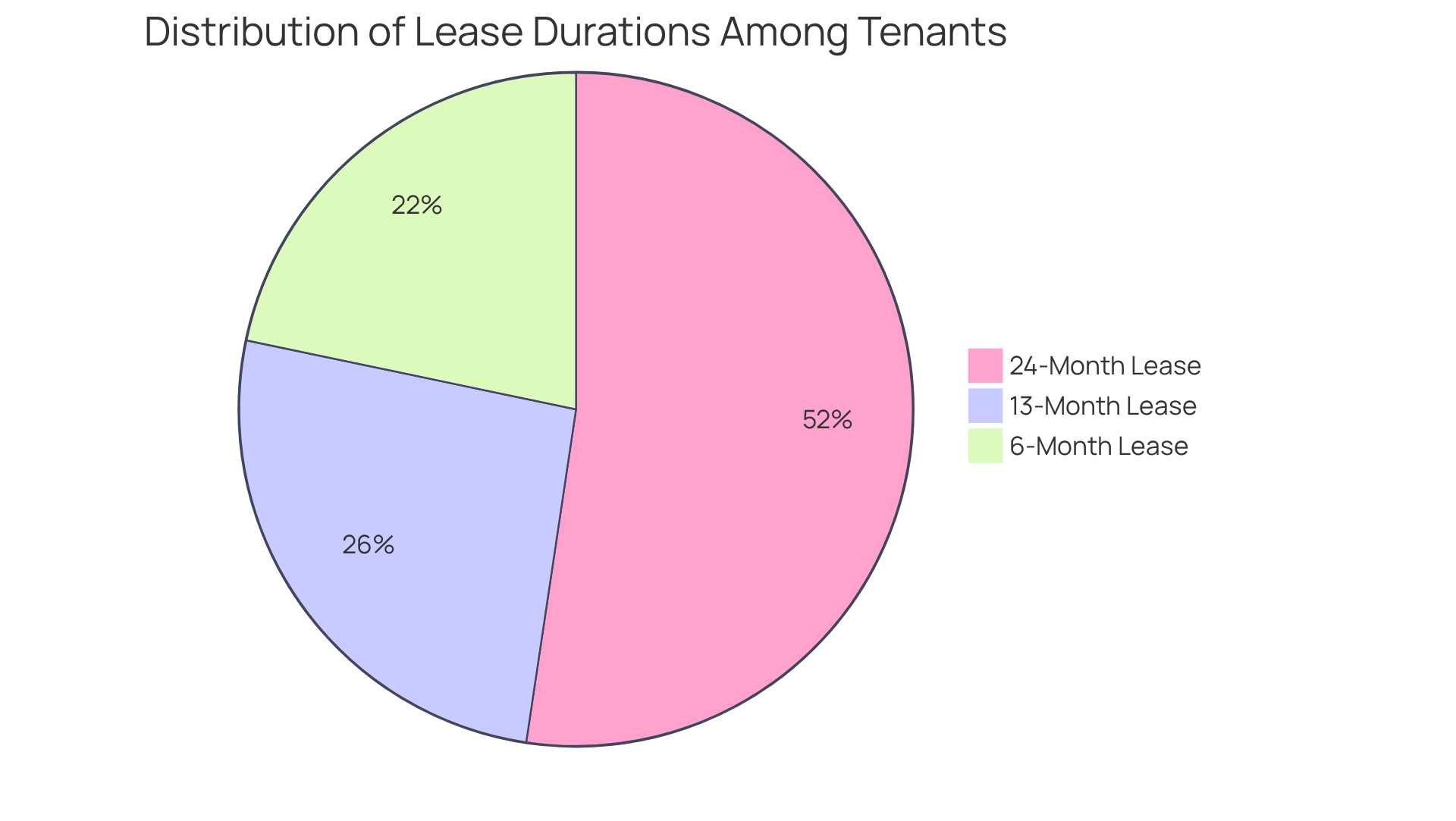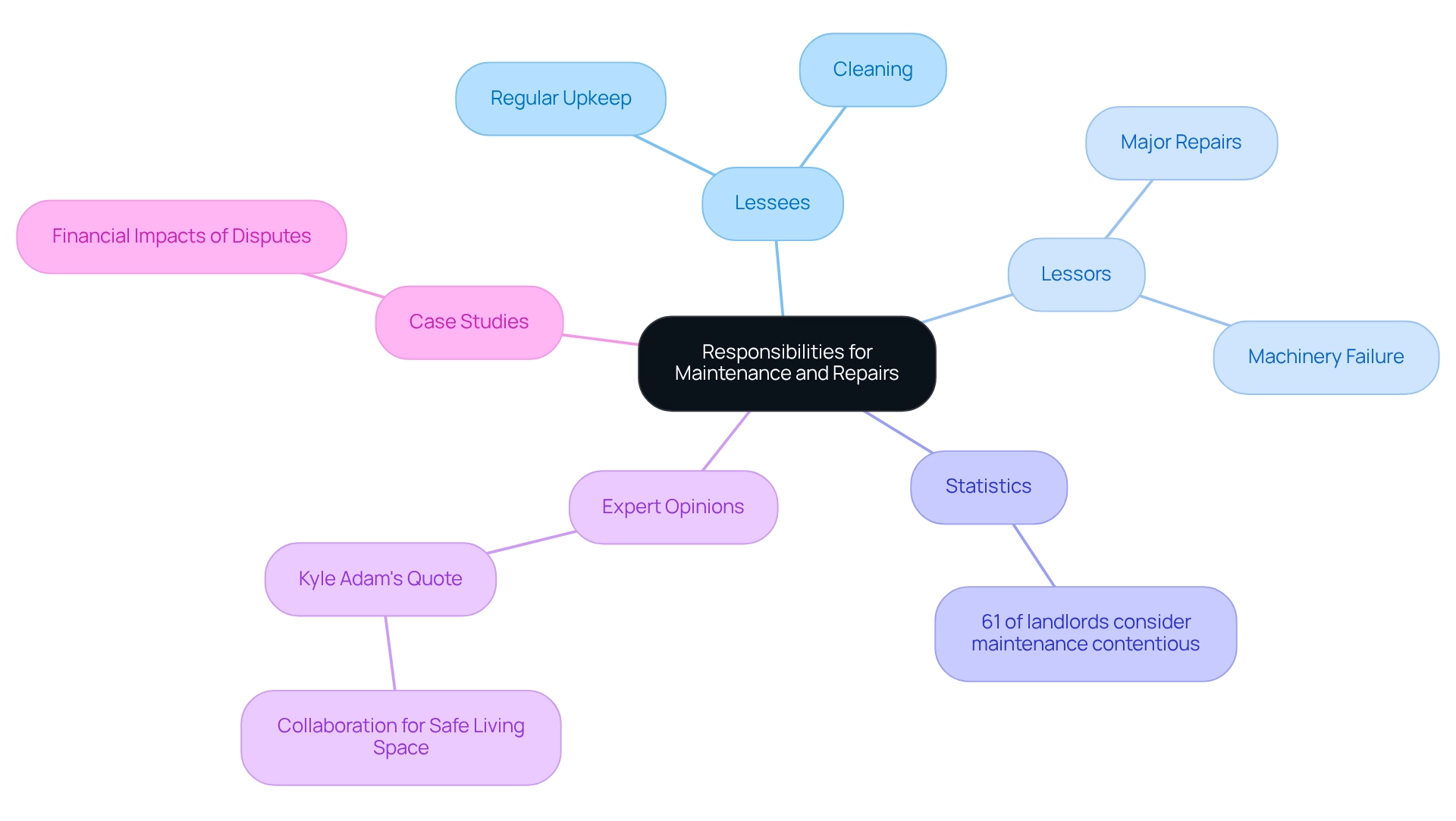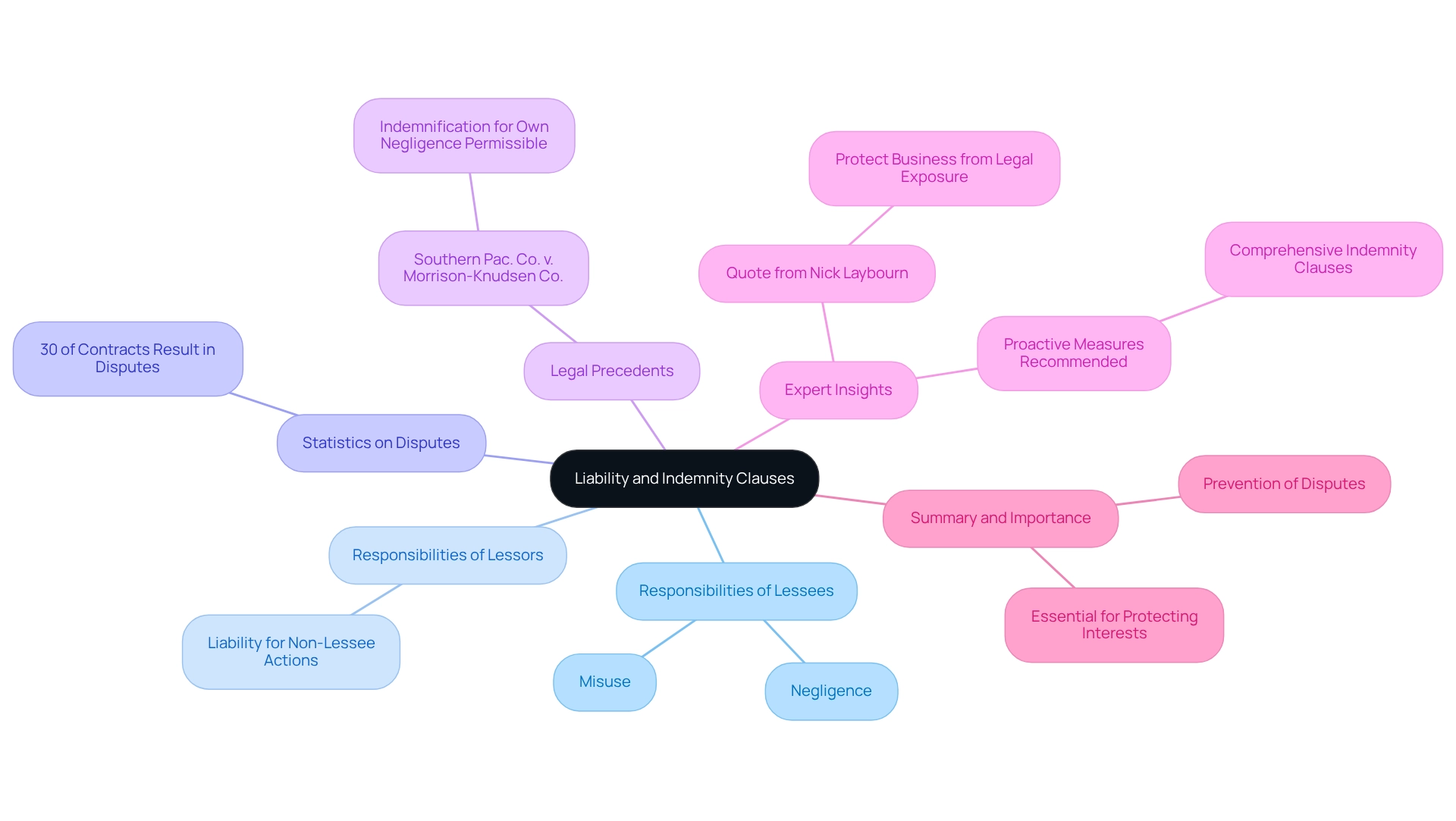Overview
The essential terms and conditions of equipment rental agreements encompass:
- Duration
- Payment terms
- Maintenance responsibilities
- Liability clauses
These elements are crucial for safeguarding the interests of both lessors and lessees. A thorough understanding of these components minimizes disputes and fosters successful leasing experiences. Case studies reveal that well-defined contracts lead to higher satisfaction rates among clients, underscoring the importance of clarity in agreements.
Key Highlights:
- Equipment rental agreements are legally binding documents that protect the interests of both lessor and lessee.
- Transparency and adaptability in lease contracts are increasingly important in the construction sector.
- Understanding the terms of rental agreements can lead to more successful leasing experiences.
- Key elements of equipment rental agreements include duration, payment terms, maintenance responsibilities, and liability clauses.
- Accurate identification of parties involved in leasing contracts is critical for accountability and conflict prevention.
- Utilizing contract management tools can significantly improve efficiency in the leasing process.
- A detailed description of leased equipment, including condition at the time of borrowing, is essential to minimize disputes.
- Clearly defining the rental period helps avoid misunderstandings regarding equipment return dates.
- Explicitly stating rental fees and payment terms is crucial for fostering trust and ensuring timely payments.
- Maintenance responsibilities should be clearly outlined to prevent conflicts and ensure equipment upkeep.
- Liability and indemnity clauses are vital to protect parties from damages or losses during the lease period.
Introduction
In the dynamic realm of equipment rentals, grasping the intricacies of rental agreements is essential for both rental companies and customers. These legally binding contracts form the backbone of transactions, delineating critical terms that safeguard the interests of all parties involved. As the construction industry evolves, the demand for transparency and flexibility in these agreements intensifies.
With significant financial implications at play—ranging from minimizing disputes to ensuring timely payments—a thorough understanding of rental agreements is vital. This article explores the key components that characterize successful equipment rental agreements, providing insights and best practices that can facilitate smoother operations and enhance project outcomes.
Understanding Equipment Rental Agreements
An equipment rental agreement's terms and conditions represent a legally binding document that delineates the terms under which equipment is borrowed, safeguarding the interests of both the lessor (the leasing company) and the lessee (the client). Such contracts are essential as they distinctly outline the equipment rental agreement's terms and conditions, expectations, responsibilities, and liabilities, thereby minimizing the potential for misunderstandings and conflicts during the leasing period.
Current trends indicate a growing emphasis on transparency and adaptability in lease contracts, reflecting the evolving demands of the construction sector. For instance, the European machinery lease market has seen a turnover of approximately 25.2 billion EUR, underscoring the vital role of well-organized contracts in facilitating seamless transactions. Additionally, Aggreko's leasing income from 2010 to 2020 highlights the robust expansion within the machinery leasing industry, further illustrating the necessity for efficient contracts.
Legal experts stress the importance of thoroughly understanding the equipment rental agreement's terms and conditions. As John Jeanguenat, president of RentalMax, remarked, "The leasing business by its nature is a green industry." This perspective is echoed by industry leaders who assert that a comprehensive grasp of these contracts can lead to more successful leasing experiences.
Moreover, statistics indicate that a significant percentage of disputes stem from ambiguous contract terms. Consequently, it is imperative for construction project managers to familiarize themselves with the essential elements of equipment rental agreement terms and conditions, including:
- Duration
- Payment terms
- Maintenance responsibilities
- Liability clauses
Case studies illustrate the effectiveness of robust leasing agreements. For example, companies that adopt detailed contracts report fewer disputes and higher satisfaction rates among clients. The industrial machinery leasing sector encompasses various product and service categories, such as:
- General industrial machinery leasing
- Light construction machinery leasing
- Medical machinery leasing
This trend emphasizes the importance of dedicating time to comprehend and negotiate favorable conditions in lease contracts, ultimately leading to more successful project outcomes.
Identifying the Parties Involved
In any machinery lease contract, the accurate identification of the parties involved is essential. This includes the full legal names and addresses of both the lessor and the lessee. Such clarity not only makes the contract enforceable but also ensures that both parties can be held accountable for their respective obligations. This is especially crucial in the construction sector, where machinery leasing conflicts can emerge regarding responsibilities and liabilities.
Statistics indicate that 67% of legal teams are designating budgets specifically for contract management tools, highlighting the increasing acknowledgment of the significance of efficient contract management in the construction field. Organizations employing contract management software have indicated an impressive 80% quicker average cycle time from bid to signed contract, significantly improving productivity and accelerating deal closures. As stated by LLC Buddy, organizations utilizing such software encounter an 80% quicker average cycle time, which is essential for sustaining efficiency in machinery leases.
Furthermore, clear identification of parties in leasing contracts can avert conflicts. For instance, case studies show that organizations that implement robust contract management practices experience fewer conflicts, as the roles and responsibilities of each party are well-defined. Legal specialists stress that accountability relies on this clarity, as it specifies who is accountable for the assets and any related liabilities.
Current trends suggest a movement towards more comprehensive leasing contracts that emphasize the equipment rental agreement terms and conditions, including the identification of parties. This proactive approach not only reduces risks but also promotes a smoother leasing process, ultimately benefiting all parties involved. By ensuring that all parties are clearly recognized, tool leasing contracts can serve as a solid basis for successful transactions.
Detailed Description of Equipment
A comprehensive description of the apparatus being leased is essential in the equipment rental agreement terms and conditions. This description must include critical details such as the make, model, serial number, and any unique identifiers associated with the apparatus. Additionally, documenting the condition of the tools at the time of borrowing is crucial.
This meticulous attention to detail not only helps prevent disputes regarding the item's condition but also ensures that both parties have a clear understanding of the equipment rental agreement terms and conditions.
Statistics indicate that disagreements over the state of equipment are a common issue in lease agreements, often leading to costly misunderstandings. By providing a thorough description, leasing companies can significantly reduce the likelihood of such disputes. Recommended practices suggest including images of the apparatus along with notes on any visible wear and tear to further substantiate the condition at the time of lease.
Expert insights underscore that capturing detailed item descriptions is not merely a formality; it is a vital component of risk management in the equipment rental agreement terms and conditions. As George Azih, Founder & Executive Chairman, states, "When collecting lease data, you need to capture a wide range of information." This highlights the importance of comprehensive documentation regarding the equipment rental agreement terms and conditions to protect both the leasing company and the customer.
Moreover, the growing emphasis on sustainability within the machinery leasing sector has prompted operators to invest in energy-efficient devices and reduce paper usage. This transition not only aligns with environmental goals but also enhances the transparency and efficiency of leasing agreements. For instance, leasing providers are increasingly utilizing electronic methods to streamline documentation, facilitating easier monitoring of apparatus conditions and descriptions.
A recent case study on sustainability initiatives in machinery leasing illustrates how operators are exploring battery-powered alternatives and implementing electronic processes to foster greener operations.
In conclusion, incorporating thorough device descriptions in lease contracts is vital for minimizing conflicts and fostering trust between leasing firms and their customers, in accordance with the equipment rental agreement terms and conditions. By ensuring that all relevant information is documented, both parties can enjoy a smoother leasing experience, ultimately benefiting construction project managers by improving project efficiency and reducing potential conflicts.
Defining the Rental Period
Specifying the lease duration in a machinery lease contract is essential, as it establishes the precise start and finish dates for the lease. This clarity prevents misunderstandings regarding when the equipment should be returned. A well-organized equipment rental agreement should encompass clauses for prolonging the lease duration, along with repercussions for overdue returns. Such stipulations ensure that both parties are fully aware of their responsibilities, helping to mitigate potential disputes.
Ambiguities in leasing periods can lead to significant issues. For example, a lack of clarity may result in unexpected charges or items being held longer than necessary, disrupting project timelines. According to recent data, 10.4% of leases that began in July 2022 encountered disputes regarding ambiguous terms, emphasizing the importance of clear definitions in machinery leasing contracts.
Expert insights underscore the necessity of defining leasing durations. Industry professionals assert that a fundamental element of any lease is clearly stating how long the equipment can be utilized. This is particularly relevant in the construction sector, where project schedules are often tight and delays can be costly. Furthermore, statistics reveal that among tenants with atypical lease durations:
- 29.9% opted for a 24-month lease
- 14.8% chose a 13-month lease
- 12.4% selected a 6-month lease
These figures illustrate the diversity of leasing needs and the significance of customizing contracts to suit specific project requirements.
Case studies provide further insight into the consequences of poorly defined leasing periods. For instance, in Massachusetts, laws limit landlords' access to leased properties, and clauses that do not comply with these restrictions are considered unenforceable. This precedent highlights the necessity for transparency in lease contracts, particularly in the equipment rental agreement terms and conditions, to safeguard both parties' rights, including those in tool leases.
In summary, detailing the leasing period in tool contracts is not merely a formality; it is a vital element that can avert conflicts and guarantee seamless operations throughout the leasing timeframe. For inquiries and reservations, customers can contact EZ Equipment Rental at (214) 951-7800.

Outlining Rental Fees and Payment Terms
The terms and conditions of equipment rental agreements must explicitly detail the leasing fees, encompassing the total cost for the leasing period, accepted payment options, and payment deadlines. It is equally essential to specify any additional charges, such as late fees or security deposits, within these agreements. For example, a recent case study revealed that nearly 60% of renters who incur a late fee experience multiple fees within a year, underscoring the significant financial repercussions of ambiguous terms.
As B. Heath Witzen from the Consumer Financial Protection Bureau emphasizes, transparency in the terms and conditions of equipment rental agreements is crucial for fostering trust between parties. Moreover, with the average late fee escalating from over $70 in September 2021 to $84 by November 2024, the necessity for clear payment terms cannot be overstated. Additionally, it is noteworthy that 12.4 percent of tenants with atypical leases had a 6-month agreement, illustrating the variety of leasing terms that can exist.
By clearly articulating the terms and conditions of equipment rental agreements, both machinery leasing firms and their clients can mitigate misunderstandings and ensure timely payments, ultimately enhancing the overall leasing experience.
Responsibilities for Maintenance and Repairs
A well-structured lease agreement is essential, as it must clearly delineate the responsibilities for maintenance and repairs throughout the leasing period. Typically, the lessee is responsible for regular upkeep, which includes cleaning and minor adjustments, while the lessor is liable for major repairs arising from machinery failure or usual wear and tear. This allocation of responsibilities is crucial; it not only aids in avoiding conflicts but also guarantees that the equipment remains in optimal condition throughout the leasing period.
Statistics reveal that maintenance responsibilities often serve as a common source of contention in rental contracts. For example, 61% of landlords consider maintenance the worst aspect of property management, underscoring the need for clarity in agreements. By explicitly stating who is responsible for what, both parties can sidestep misunderstandings that could lead to costly disputes.
Expert opinions further underscore the necessity of these specifications. As Kyle Adam, a Senior Marketing Writer and Editor, aptly notes, "Landlords and tenants must collaborate to uphold a safe and habitable living space." This collaborative approach is vital for nurturing a positive relationship between lessors and lessees, ultimately enhancing the durability and performance of assets.
Furthermore, case studies indicate that disputes over maintenance can lead to significant downtime and financial losses, making it imperative for leasing agreements to address these issues comprehensively.
In summary, a comprehensive outline of maintenance duties in machinery leasing contracts, as dictated by the equipment rental agreement terms and conditions, not only safeguards the interests of both parties but also enhances a smoother leasing experience. This ensures that machinery is well-kept and functional throughout its use. Additionally, the broader context of lease contracts, such as the $46 billion designated by Congress to aid tenants during the pandemic, highlights the significance of clear duties in upholding leasing relationships.

Liability and Indemnity Clauses
Liability and indemnity clauses are essential components of any machinery lease contract, clearly outlining the obligations of both parties in the event of damages or losses during the leasing period. Typically, the lessee is responsible for harm caused by misuse or negligence, while the lessor retains liability for failures not linked to the lessee's actions.
The significance of these clauses cannot be overstated; they protect both parties and provide clarity regarding their respective liabilities. For example, a study indicated that conflicts over apparatus leasing responsibilities are a frequent issue, with nearly 30% of leasing contracts resulting in some type of contention concerning damages. This statistic underscores the necessity of having well-defined liability clauses in place.
Moreover, indemnity provisions can effectively shield parties from liability, provided they are meticulously drafted in accordance with applicable laws. A landmark case, Southern Pac. Co. v. Morrison-Knudsen Co., established that in Oregon, indemnification for one's own negligence is permissible if the language is explicit and clear. This precedent highlights the importance of precise wording in indemnity clauses to ensure enforceability.
Expert insights suggest that taking proactive measures, such as including comprehensive indemnity clauses, can significantly mitigate unforeseen legal and financial risks. Legal professionals emphasize that these clauses are not mere formalities; they are critical safeguards that can protect businesses from substantial liabilities. As Nick Laybourn noted, "Taking these proactive steps can help protect your business from unforeseen legal and financial exposure."
In summary, including strong liability and indemnity clauses in the equipment rental agreement terms and conditions is essential for protecting the interests of both lessors and lessees. By clearly defining responsibilities and protections, these clauses help prevent disputes and foster a more secure leasing experience. For more information on how to ensure your rental agreements are comprehensive, contact EZ Equipment Rental at (214) 951-7800.

Conclusion
Understanding the intricacies of equipment rental agreements is essential for all parties involved in the rental process. A well-structured agreement not only clearly defines the roles and responsibilities of the lessor and lessee but also minimizes potential disputes through transparency and thorough documentation. Key components such as:
- Identification of parties
- Detailed equipment descriptions
- Defined rental periods
- Payment terms
- Maintenance responsibilities
- Liability clauses
all play a crucial role in fostering successful rental transactions.
As the construction industry continues to evolve, the demand for clear and flexible rental agreements becomes increasingly important. By prioritizing transparency and understanding of these agreements, rental companies and customers can navigate their relationships more effectively, ensuring smooth operations and enhanced project outcomes. Statistics underscore the value of comprehensive agreements, revealing that clear terms significantly reduce the likelihood of disputes and foster trust between parties.
Ultimately, investing time in crafting detailed and precise rental agreements not only protects the interests of both lessors and lessees but also contributes to the efficiency and success of construction projects. Emphasizing clarity in every aspect of the rental process can lead to improved satisfaction, fewer conflicts, and a more robust rental experience. As the industry moves forward, embracing these best practices will be essential for achieving long-term success and sustainability in equipment rentals.
Frequently Asked Questions
What is an equipment rental agreement?
An equipment rental agreement is a legally binding document that outlines the terms under which equipment is borrowed, protecting the interests of both the leasing company (lessor) and the client (lessee).
Why are equipment rental agreements important?
They are important because they clearly define the terms, expectations, responsibilities, and liabilities associated with the rental, helping to minimize misunderstandings and conflicts during the leasing period.
What current trends are affecting equipment rental agreements?
There is a growing emphasis on transparency and adaptability in lease contracts, particularly in response to the evolving demands of the construction sector.
What are some essential elements of equipment rental agreements?
Essential elements include duration, payment terms, maintenance responsibilities, and liability clauses.
What impact do well-organized contracts have on the machinery leasing industry?
Well-organized contracts facilitate seamless transactions and contribute to the growth of the machinery leasing industry, as evidenced by significant market turnover and company income growth.
How can disputes be minimized in equipment rental agreements?
Disputes can be minimized by ensuring clarity in contract terms, as a significant percentage of disputes arise from ambiguous language.
What should be included in the identification of parties in a lease contract?
The full legal names and addresses of both the lessor and the lessee should be included to ensure enforceability and accountability.
What role does contract management play in the leasing process?
Efficient contract management can significantly improve productivity, with organizations reporting faster cycle times from bid to signed contract, thus enhancing deal closures.
How does clarity in identifying parties help avoid conflicts?
Clear identification of parties helps define roles and responsibilities, reducing the likelihood of conflicts related to obligations and liabilities.
What benefits arise from comprehensive leasing contracts?
Comprehensive leasing contracts reduce risks and promote smoother leasing processes, ultimately benefiting all parties involved by ensuring clear recognition of responsibilities.




